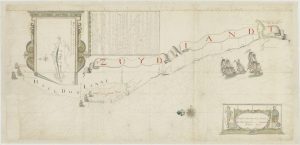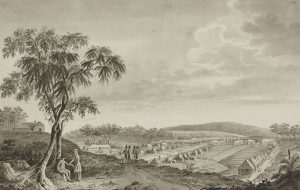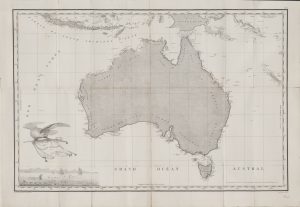10 Non-British European expeditions to the Australian continent
In the end, colonisation and exploration of the Australian continent was largely a British project. Large parts of the coastline had been mapped by Dutch voyagers in service of Dutch East India Company interests in Asia, some land expeditions (most notably those of Ludwig Leichhardt) included Europeans of non-British origin, but the history of Australian exploration and increasing European knowledge of the continent is a largely British one. That was not a foregone conclusion: other European powers were involved in Pacific exploration, and French explorers surveyed the Australian coastline and were seen as threatening British colonial projects on the continent.

Britain was not the only European state interested in the potential of colonisation. The Dutch had partially mapped the northern, western, and southern fringes of the Australian continent before Cook’s charting of the east coast. The knowledge obtained by the Dutch-led them to avoid the continent, rather than seek to set up trading posts or colonies. Within the Pacific, Britain was only one of several European states to engage in exploration and annexation. In particular, the frequency of French expeditions increased from the late-eighteenth century onwards, and France sought to claim places judged to be of ongoing value. For French explorers, interest in the Pacific led them to explore portions of the Australian coast.
Two French expeditions to the Pacific around the time of Cook’s Endeavour voyage skirted the Australian continent. During his 1766-9 circumnavigation of the world, French navigator Louis-Antoine de Bougainville saw sections of what is now known as the Great Barrier Reef. Despite sighting, naming, and mapping several reefs in roughly the region where the Endeavour soon after experienced severe difficulty, Bougainville did not chart or claim the east coast of the Australian continent. While some of Bougainville’s sailors claimed they sighted land, Bougainville protected his ships by declining to explore further. French navigator Jean-François de Surville’s 1769-70 voyage to the Pacific overlapped with Cook’s Endeavour voyage. De Surville and Cook narrowly missed encountering each other in Aotearoa (New Zealand). Before reaching Aotearoa, de Surville had passed between New Caledonia and the Australian coast: de Surville remained further from the continent than Bougainville but his was another French voyage that skirted Australia’s east coast before Cook mapped it.

Australia was also visited by a Spanish expedition shortly after the establishment of the colony at Sydney. Alejandro Malaspina (himself Italian) sailed from Spain in 1789. He explored the coasts of North and South America, followed the traditional Spanish route across the Pacific to Manila, but took a more southerly route on his return. He visited the new British colony in New South Wales, then called at islands in central Polynesia, before returning to Spain in 1794.
The French presence in the Pacific increased from the late eighteenth century onwards. In the period between Cook’s Endeavour voyage and the establishment of the Sydney settlement, the French navigator Marion Dufresne skirted the south of the Australian continent, landing in what is now Tasmania in 1772 (Cook visited Tasmania in 1776). The southern outline of that island had already been mapped by the Dutch explorer Abel Tasman in 1642. French navigators visited other parts of the Australian coast previously mapped by the Dutch, and in 1772 French navigator Louis François Marie Aleno de Saint Aloüarn landed on Dirk Hartog Island, and claimed New Holland for France.
The settlement of Sydney marked a shift in exploration of the Pacific as it was a European port on the western edge of the Pacific Ocean. The establishment of Sydney also marked the consolidation of British claims to New South Wales, and subsequently the Australian continent, following James Cook’s claim of possession in 1770. The arrival of the First Fleet in Botany Bay in 1788 was followed eight days later by that of the French navigator Jean François de Galaup, comte de Lapérouse. The presence of the First Fleet was significant in two ways: it marked Britain’s claim to the region of New South Wales, and (despite the First Fleet being in the process of shifting its colonisation attempt from Botany Bay to Port Jackson) it made the site enough of a European port that Lapérouse was able to leave a copy of his journal there to be returned to Europe. Before his arrival in Botany Bay Lapérouse had undertaken extensive exploration in the Pacific, after his departure he was shipwrecked at Vanikoro (now part of the Solomon Islands) and lost from European knowledge until 1826. Sydney’s role as a European port meant that Lapérouse’s earlier observations survived the destruction of his vessels.
In 1791 French explorer Bruni D’Entrecasteaux was sent to the Pacific to search for Lapérouse. D’Entrecasteaux landed in Tasmania in 1792, then completed a very loose circumnavigation of the Australian continent, passing closer to New Caledonia than to the Australian coast, visiting the Moluccas, then landing on the western coast of the Australian continent before returning to Tasmania and then landing at New Caledonia. The expedition did not visit Sydney. D’Entrecasteaux died during the voyage, which was further disrupted by European politics in the aftermath of the French Revolution. Loyalties within the expedition were split, and the expedition’s records were claimed by various foreign powers. In 1796 the records and specimens taken during the expedition finally arrived in France, in part through the intercession of Sir Joseph Banks.

In 1801-3 Matthew Flinders’ expedition mapped the coastlines of New South Wales and New Holland, and confirmed those two regions were part of one continent. That voyage was shadowed by a French scientific expedition under the command of Nicholas Baudin. Baudin’s expedition departed France in 1800, explored the western, northern, and southern Australian coasts, and encountered Flinders’ expedition in Encounter Bay. After that encounter Baudin’s ships headed to Sydney, where the expedition remained for several months before returning south to complete exploration of the region around Van Diemen’s Land and along the southern coast of the continent. The expedition’s interest in Van Diemen’s Land triggered a hastily arranged expedition from Sydney that consolidated Britain’s claim to the southern portion of New South Wales. While Baudin’s expedition did not circumnavigate the continent, it resulted in the first published map of what the French named Terre Napoleon and Flinders suggested be called Australia.
French interest in the Pacific continued throughout the nineteenth century, and French expeditions continued to visit Australian shores. Louis de Freycinet’s 1817-20 voyage around the world visited the northwest coast of Australia, and the settlement at Sydney. De Freycinet was a veteran of the Baudin expedition and had visited Sydney previously. French explorer Louis Isidore Duperrey visited the western and southern coasts of Australia, as well as calling in at Sydney, during his 1822-5 circumnavigation of the world. Hyacinthe de Bougainville (veteran of the Baudin expedition and son of Louis-Antoine de Bougainville), visited the west coast, Van Diemen’s Land and Sydney during his 1824-6 circumnavigation of the world. During his 1826-9 Pacific expedition Jules Dumont d’Urville (veteran of the Duperrey expedition) called at King George Sound, Westernport, Jervis Bay and Sydney before exploring the Pacific. That expedition visited Hobart while conducting a loose circumnavigation of Australia before returning to Europe. During his 1837-40 circumnavigation of the world d’Urville visited Hobart twice. Cyrille Pierre Théodore Laplace landed in both Van Diemen’s Land and Sydney during his 1830-2 global circumnavigation.
The presence of French voyagers on Australian shores before 1840 marked the dual colonising interests of the two European powers. In Australasia Britain outmaneuvered France, at times establishing colonies precisely to thwart French interests. This was the case in Aotearoa in 1840 when the British signed the Treaty of Waitangi to claim sovereignty over the islands in the face of French interests that extended to land purchase and plans for a French colony at Akaroa. Inspired by the apparent success of Sydney as a colony and a solution to the management of criminals, in 1864 France established New Caledonia as a penal settlement, only 1500km from the Australian coast.
British and French ambitions in the Pacific were linked, as European states competed for colonies throughout the world in the eighteenth and nineteenth centuries. From the late eighteenth century European technology made navigation of the Pacific more reliable, and Britain and France both turned to scientific survey and exploration as a way to establish national prestige. That the Australian continent would be fully claimed by Britain was not a foregone conclusion, and the continuing presence of French explorers along its coast links the history of Australian exploration to that of the Pacific, and to the European rivalries that played out there.
Links
Explorer Journals
Bougainville, Hyacinthe de. “Journal and Other Documents of Hyacinthe Hypolite Yves Philippe Potentin de Bougainville.” Translated by Malcolm Leader. The Boudin Legacy Project, University of Sydney. Uploade July 2019. https://baudin.sydney.edu.au/wp-content/uploads/2019/07/bougainvilleenglish.pdfArchives nationales de France, 155 AP6
Bougainville, Louis-Antoine de. Voyage Autour du Monde par la Frégate du roi La Boudeuse et la flûte L’Étoile, en 1766, 1767, 1768 & 1769. Neuchâtel, 1771; Project Gutenberg, 2021. https://www.gutenberg.org/ebooks/28485
d’Urville, Dumont. Jules-Sébastien-César. Voyage de la Corvette l’Astrolabe éxécuté par Ordre du roi, Pendant les Années 1826-1827-1828-1829, Vol I. Paris: J Tastu, 1830. https://archive.org/details/voyageautourdum01durgoog/page/n6/mode/2up
d’Urville, Dumont. Jules-Sébastien-César. Voyage de la Corvette l’Astrolabe éxécuté par Ordre du roi, Pendant les Années 1826-1827-1828-1829, Vol II. Paris: J Tastu, 1830. https://archive.org/details/voyagedelacorvet12dumo/page/n7/mode/2up
d’Urville, Dumont. Jules-Sébastien-César. Voyage de la Corvette l’Astrolabe éxécuté par Ordre du roi, Pendant les Années 1826-1827-1828-1829, Vol III. Paris: J Tastu, 1831. https://archive.org/details/bub_gb_xnjTkGszQ5EC/page/n5/mode/2up
d’Urville, Dumont. Jules-Sébastien-César. Voyage au Pole sud et dans l’Océanie sur les Corvettes l’Astrolabe et la Zélée, Exécuté par Ordre du roi Pendant les Années 1837-1838-1839-1840, Vol I. https://archive.org/details/voyageaupolesud00jacqgoog/page/n8/mode/2up, Paris: Gide et J. Baudry, 1844
d’Urville, Dumont. Jules-Sébastien-César. Voyage au Pole sud et dans l’Océanie sur les Corvettes l’Astrolabe et la Zélée, Exécuté par Ordre du roi Pendant les Années 1837-1838-1839-1840, Vol II, Paris: Gide et J. Baudry, 1844. https://archive.org/details/voyageaupolesud03durgoog/page/n8/mode/2up
Freycinet, Louis Claude Desaulese de. Rapport fait a l’Académie Royale des Sciences de l’institut dans la Séance du 12 Décembre 1820 : par le Capitaine Louis de Freycinet, sur son Voyage Autour du Monde, Exécuté Pendant les Années 1817, 1818, 1819 et 1820. Brussels: l’imprimerie de Weissenbruch, c. 1820. http://handle.slv.vic.gov.au/10381/101389
Laplace, Cyrille. Campagne de Circumnavigation de la Frégate l’Artémise, Pendant les Années 1837, 1838, 1839, et 1840, sous le Commandement de M. Laplace. Publ. par Ordre du roi, sous les Auspices du Ministre de la Marine. Paris: A. Bertrand, 1841. https://archive.org/details/campagnedecircu00laplgoog
Leichhardt, Ludwig. Journal of an Overland Expedition in Australia: From Moreton Bay to Port Essington, a Distance of Upwards of 3000 miles, During the Years 1844-1845. London: T. and W. Boone, 1847. https://www.gutenberg.org/ebooks/5005
Péron, François. Voyage de Decouvertes aux Terres Australes, Execute par Ordre de sa Majeste, l’Empereur et Roi, sur les Corvettes le Geographe, le Naturaliste et la Goelette le Casuarina, Pendant les Annees 1800, 1801, 1802, 1803 et 1804. Paris: De L’Imprimerie Impériale, 1807. https://viewer.slv.vic.gov.au/?entity=IE9840638&mode=browse
Video material
Further videos:
A lecture on French Encounters in New Holland, presented by Shino Konishi and Global Encounters & First Nations People, https://vimeo.com/519309370?embedded=true&source=vimeo_logo&owner=13123923
Open Access Secondary Sources
Douglas, Bronwen, Fanny Wonu Veys, Billie Jane Lythberg, eds. Collecting in the South Sea: The Voyage of Bruni D’Entrecasteaux 1791-1794. Leiden: Sidestone Press, 2018. https://www.researchgate.net/publication/329706322_Collecting_in_the_South_Sea_The_Voyage_of_Bruni_d’Entrecasteaux_1791-1794
Gerritsen, Rupert, Robert King and Andrew Eliason, eds. “The Freycinet Map of 1811: Proceedings of the Symposium Commemorating the 200th Anniversary of the Publication of the First Map of Australia.” Australia on the Map, 2012. https://www.australiaonthemap.org.au/category/freycinet-map/.
Hiroa, Te Rangi. Explorers of the Pacific: European and American Discoveries in Polynesia. Honolulu: Bernice P. Bishop Museum, 1953. http://nzetc.victoria.ac.nz/tm/scholarly/BucExpl-fig-BucExplTit.html
Keats, Bethany. “On the Run: French Convicts in North Queensland.” ArcadiaNQ 2, 2021. https://arcadianq.wordpress.com/on-the-run/
McGowan, Barry. “Convicts and Communards: French-Australian Relations in the South Pacific, 1800–1900.” Institute for the Study of French-Australian Relations. c. 2018. https://www.isfar.org.au/wp-content/uploads/2018/09/64_BARRY-McGOWAN-Convicts-Communards.pdf
Olcelli, Laura. “Alessandro Malaspina: An Italian-Spaniard at Port Jackson.” Sydney Journal 4, no. 1. (2013): 38–48. https://www.researchgate.net/publication/326471723_Alessandro_Malaspina_An_ItalianSpaniard_at_Port_Jackson
West-Sooby, John, ed. Discovery and Empire: The French in the South Seas. Adelaide: The University of Adelaide Press, 2013. https://library.oapen.org/handle/20.500.12657/33183
Western Australian Museum. “Journeys of Enlightenment: French Exploration of Terres Australes.” Accessed March 30, 2022. https://museum.wa.gov.au/exhibitions/journeys/index.html
Western Australian Museum. “The Uranie Voyage.” Accessed March 30, 2022. https://museum.wa.gov.au/research/research-areas/maritime-archaeology/treasures-from-the-deep/uranie-voyage
Other secondary sources
Fornasiero, Jean, Peter Monteath and John West-Sooby, Encountering Terra Australis: The Australian Voyages of Nicolas Baudin and Matthew Flinders. Kent Town, South Australia: Wakefield Press, 2004.
Hunt, Susan, Martin Terry, Nicholas Thomas, eds. Lure of the Southern Seas: The Voyages of Dumont d’Urville 1826-1840. Sydney: Historic Houses Trust of New South Wales, 2002.
Kendrick, John. Alejandro Malaspina: Portrait of a Visionary. Montreal: McGill-Queen’s University Press, 2014.

